Analyzing Policy, Politics, and Law: Mental Health Reform in Australia
VerifiedAdded on 2023/01/18
|6
|1590
|98
Essay
AI Summary
This essay examines the political and socio-economic factors influencing mental health and alcohol and other drug services reform in Australia. It discusses how the federated system of government, with its division of responsibilities between Federal and state/territory governments, impacts service delivery. The essay highlights the role of the National Mental Health Strategy (NMHS) and various government plans in shaping mental health services. It also addresses the involvement of non-governmental organizations like Beyond Blue and the challenges in reducing suicide rates despite ongoing prevention efforts. The importance of informal carers in supporting individuals with mental illness is also acknowledged, emphasizing the comprehensive range of health and non-health services available at the subnational level under the supervision of state and territory governments.
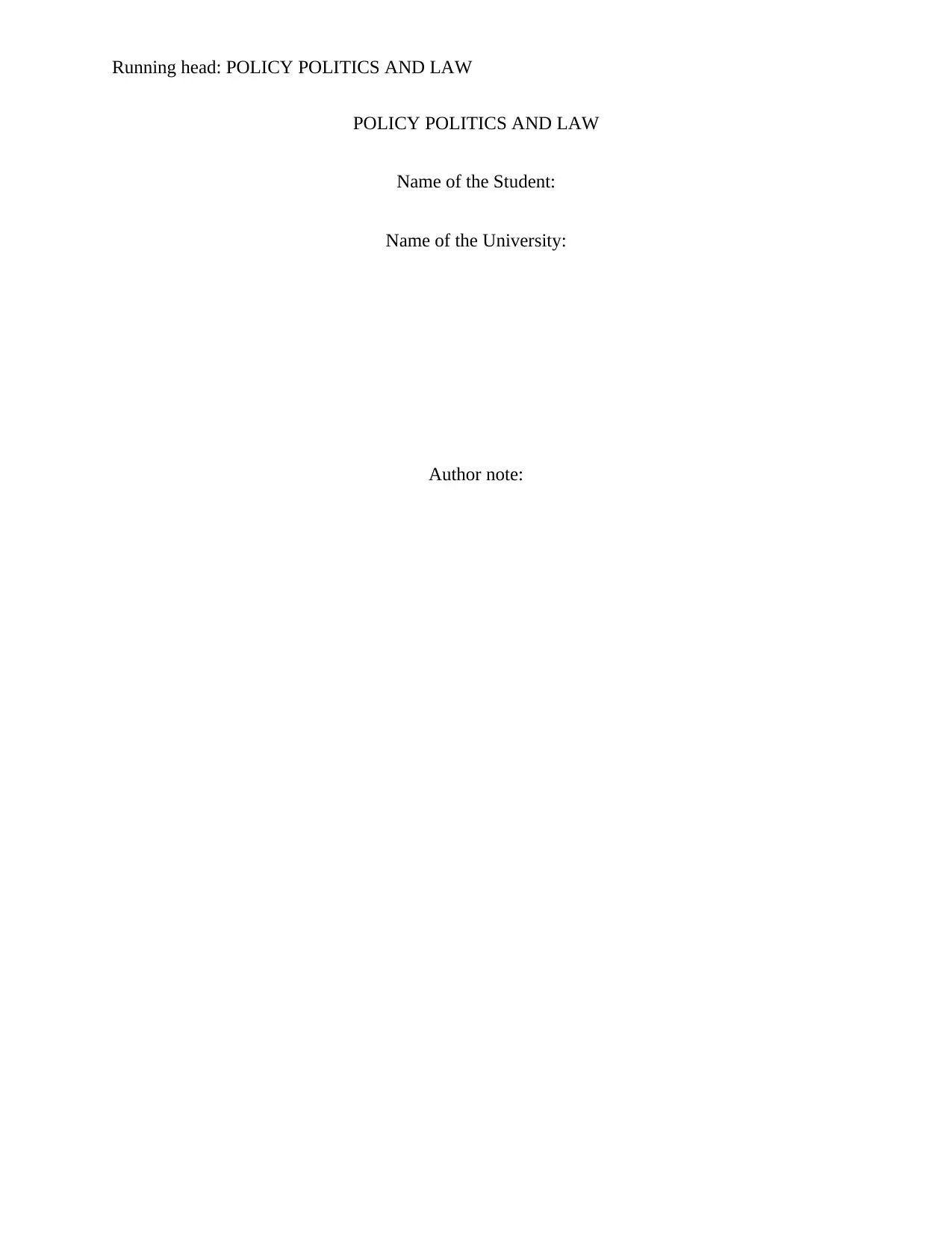
Running head: POLICY POLITICS AND LAW
POLICY POLITICS AND LAW
Name of the Student:
Name of the University:
Author note:
POLICY POLITICS AND LAW
Name of the Student:
Name of the University:
Author note:
Paraphrase This Document
Need a fresh take? Get an instant paraphrase of this document with our AI Paraphraser
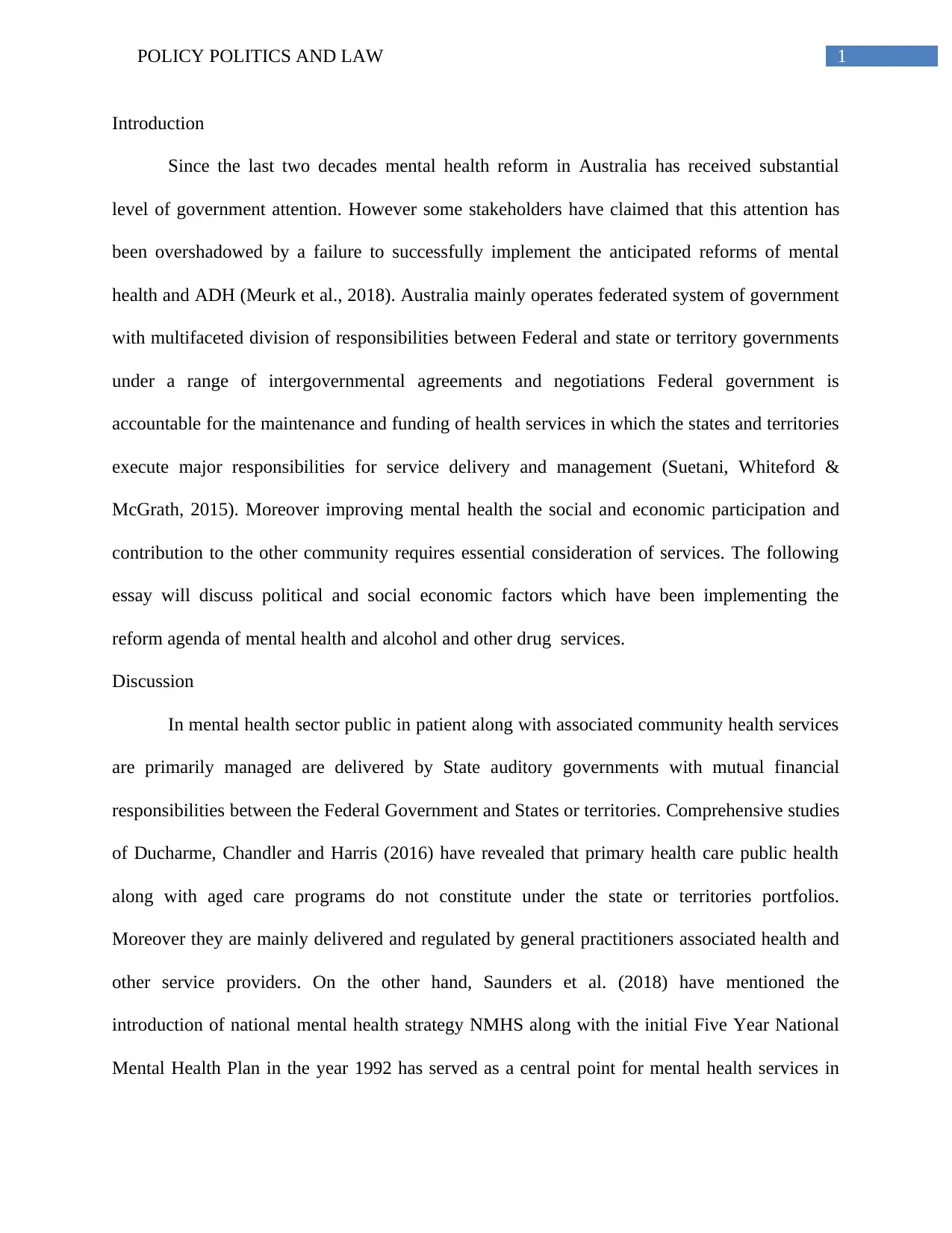
1POLICY POLITICS AND LAW
Introduction
Since the last two decades mental health reform in Australia has received substantial
level of government attention. However some stakeholders have claimed that this attention has
been overshadowed by a failure to successfully implement the anticipated reforms of mental
health and ADH (Meurk et al., 2018). Australia mainly operates federated system of government
with multifaceted division of responsibilities between Federal and state or territory governments
under a range of intergovernmental agreements and negotiations Federal government is
accountable for the maintenance and funding of health services in which the states and territories
execute major responsibilities for service delivery and management (Suetani, Whiteford &
McGrath, 2015). Moreover improving mental health the social and economic participation and
contribution to the other community requires essential consideration of services. The following
essay will discuss political and social economic factors which have been implementing the
reform agenda of mental health and alcohol and other drug services.
Discussion
In mental health sector public in patient along with associated community health services
are primarily managed are delivered by State auditory governments with mutual financial
responsibilities between the Federal Government and States or territories. Comprehensive studies
of Ducharme, Chandler and Harris (2016) have revealed that primary health care public health
along with aged care programs do not constitute under the state or territories portfolios.
Moreover they are mainly delivered and regulated by general practitioners associated health and
other service providers. On the other hand, Saunders et al. (2018) have mentioned the
introduction of national mental health strategy NMHS along with the initial Five Year National
Mental Health Plan in the year 1992 has served as a central point for mental health services in
Introduction
Since the last two decades mental health reform in Australia has received substantial
level of government attention. However some stakeholders have claimed that this attention has
been overshadowed by a failure to successfully implement the anticipated reforms of mental
health and ADH (Meurk et al., 2018). Australia mainly operates federated system of government
with multifaceted division of responsibilities between Federal and state or territory governments
under a range of intergovernmental agreements and negotiations Federal government is
accountable for the maintenance and funding of health services in which the states and territories
execute major responsibilities for service delivery and management (Suetani, Whiteford &
McGrath, 2015). Moreover improving mental health the social and economic participation and
contribution to the other community requires essential consideration of services. The following
essay will discuss political and social economic factors which have been implementing the
reform agenda of mental health and alcohol and other drug services.
Discussion
In mental health sector public in patient along with associated community health services
are primarily managed are delivered by State auditory governments with mutual financial
responsibilities between the Federal Government and States or territories. Comprehensive studies
of Ducharme, Chandler and Harris (2016) have revealed that primary health care public health
along with aged care programs do not constitute under the state or territories portfolios.
Moreover they are mainly delivered and regulated by general practitioners associated health and
other service providers. On the other hand, Saunders et al. (2018) have mentioned the
introduction of national mental health strategy NMHS along with the initial Five Year National
Mental Health Plan in the year 1992 has served as a central point for mental health services in
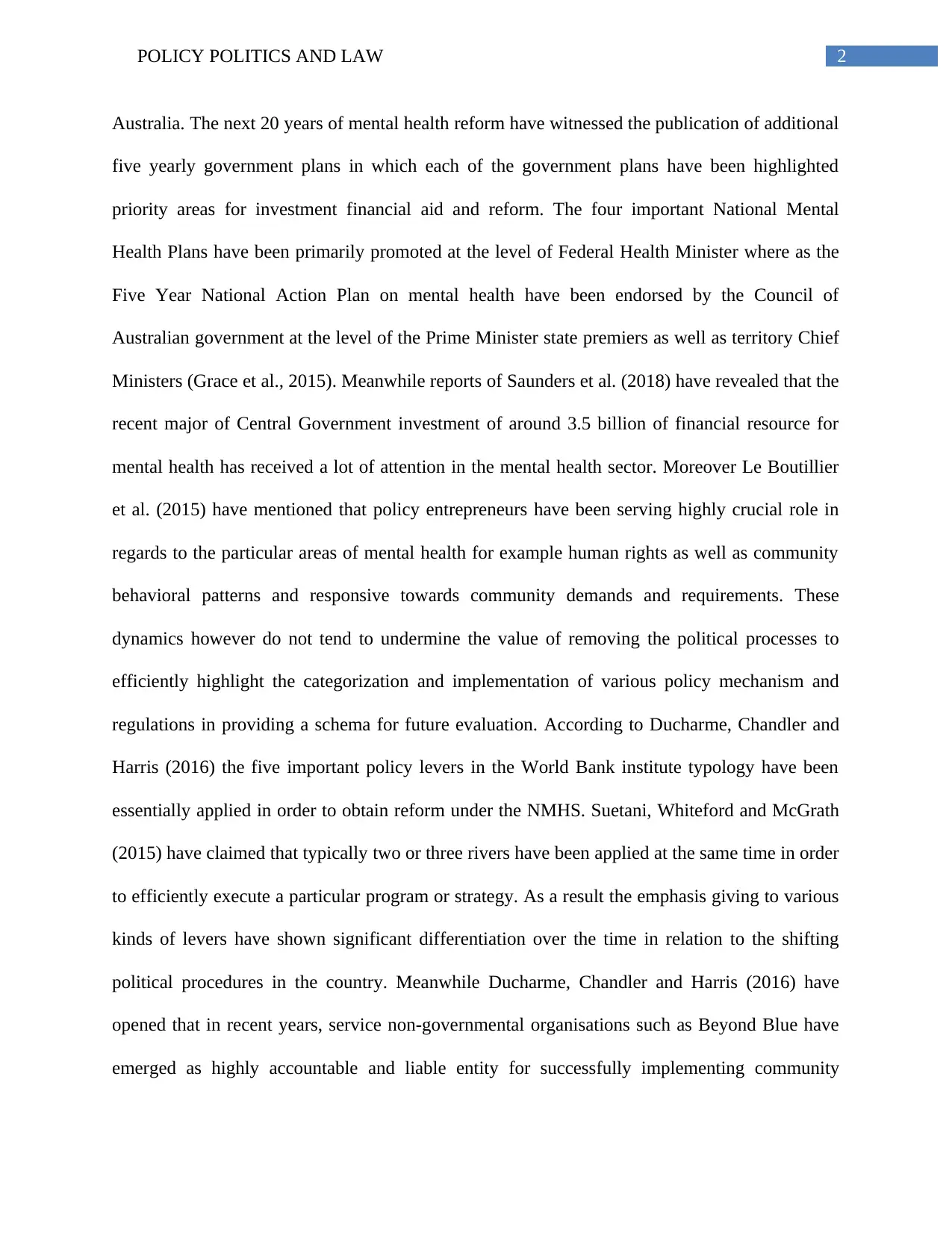
2POLICY POLITICS AND LAW
Australia. The next 20 years of mental health reform have witnessed the publication of additional
five yearly government plans in which each of the government plans have been highlighted
priority areas for investment financial aid and reform. The four important National Mental
Health Plans have been primarily promoted at the level of Federal Health Minister where as the
Five Year National Action Plan on mental health have been endorsed by the Council of
Australian government at the level of the Prime Minister state premiers as well as territory Chief
Ministers (Grace et al., 2015). Meanwhile reports of Saunders et al. (2018) have revealed that the
recent major of Central Government investment of around 3.5 billion of financial resource for
mental health has received a lot of attention in the mental health sector. Moreover Le Boutillier
et al. (2015) have mentioned that policy entrepreneurs have been serving highly crucial role in
regards to the particular areas of mental health for example human rights as well as community
behavioral patterns and responsive towards community demands and requirements. These
dynamics however do not tend to undermine the value of removing the political processes to
efficiently highlight the categorization and implementation of various policy mechanism and
regulations in providing a schema for future evaluation. According to Ducharme, Chandler and
Harris (2016) the five important policy levers in the World Bank institute typology have been
essentially applied in order to obtain reform under the NMHS. Suetani, Whiteford and McGrath
(2015) have claimed that typically two or three rivers have been applied at the same time in order
to efficiently execute a particular program or strategy. As a result the emphasis giving to various
kinds of levers have shown significant differentiation over the time in relation to the shifting
political procedures in the country. Meanwhile Ducharme, Chandler and Harris (2016) have
opened that in recent years, service non-governmental organisations such as Beyond Blue have
emerged as highly accountable and liable entity for successfully implementing community
Australia. The next 20 years of mental health reform have witnessed the publication of additional
five yearly government plans in which each of the government plans have been highlighted
priority areas for investment financial aid and reform. The four important National Mental
Health Plans have been primarily promoted at the level of Federal Health Minister where as the
Five Year National Action Plan on mental health have been endorsed by the Council of
Australian government at the level of the Prime Minister state premiers as well as territory Chief
Ministers (Grace et al., 2015). Meanwhile reports of Saunders et al. (2018) have revealed that the
recent major of Central Government investment of around 3.5 billion of financial resource for
mental health has received a lot of attention in the mental health sector. Moreover Le Boutillier
et al. (2015) have mentioned that policy entrepreneurs have been serving highly crucial role in
regards to the particular areas of mental health for example human rights as well as community
behavioral patterns and responsive towards community demands and requirements. These
dynamics however do not tend to undermine the value of removing the political processes to
efficiently highlight the categorization and implementation of various policy mechanism and
regulations in providing a schema for future evaluation. According to Ducharme, Chandler and
Harris (2016) the five important policy levers in the World Bank institute typology have been
essentially applied in order to obtain reform under the NMHS. Suetani, Whiteford and McGrath
(2015) have claimed that typically two or three rivers have been applied at the same time in order
to efficiently execute a particular program or strategy. As a result the emphasis giving to various
kinds of levers have shown significant differentiation over the time in relation to the shifting
political procedures in the country. Meanwhile Ducharme, Chandler and Harris (2016) have
opened that in recent years, service non-governmental organisations such as Beyond Blue have
emerged as highly accountable and liable entity for successfully implementing community
⊘ This is a preview!⊘
Do you want full access?
Subscribe today to unlock all pages.

Trusted by 1+ million students worldwide
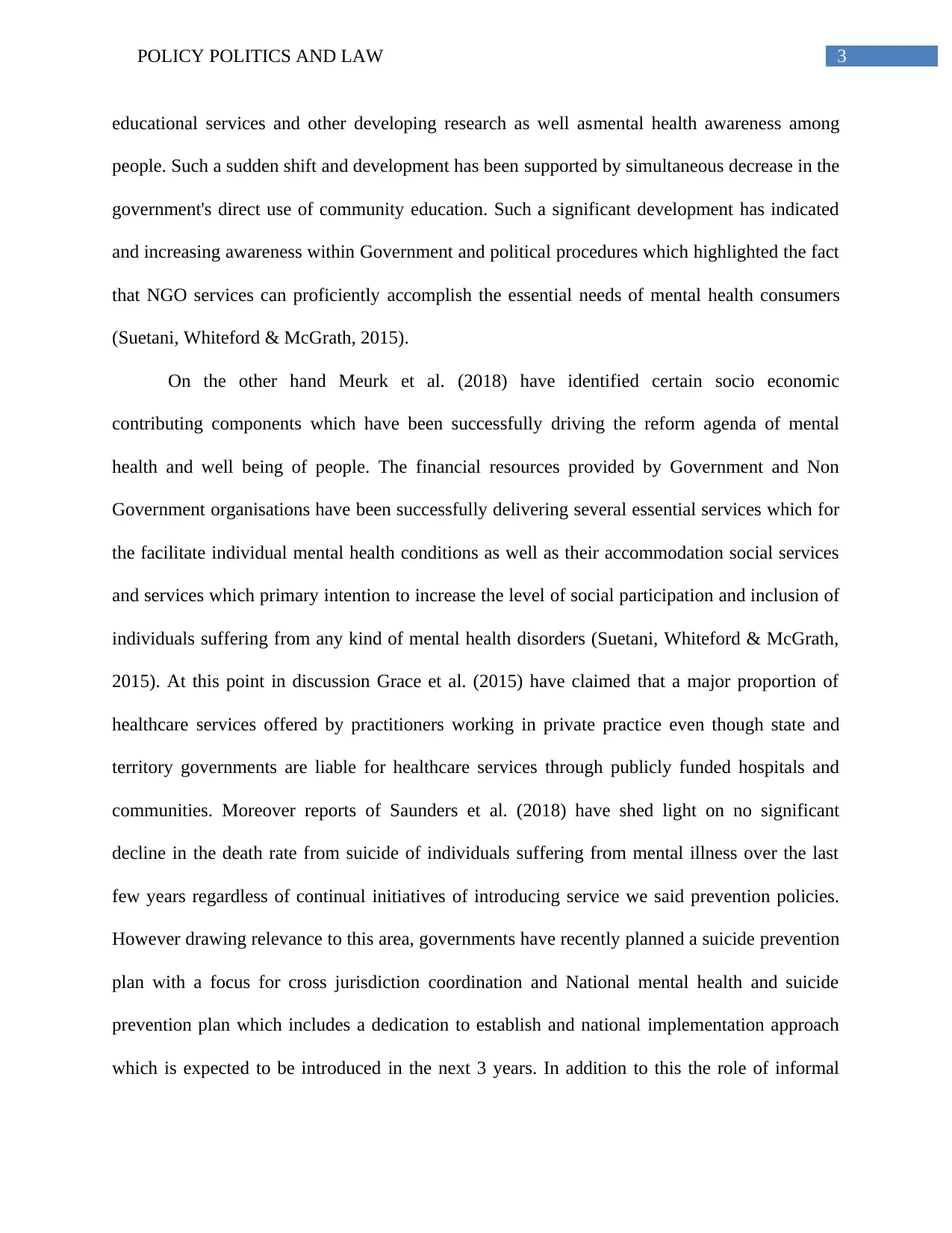
3POLICY POLITICS AND LAW
educational services and other developing research as well asmental health awareness among
people. Such a sudden shift and development has been supported by simultaneous decrease in the
government's direct use of community education. Such a significant development has indicated
and increasing awareness within Government and political procedures which highlighted the fact
that NGO services can proficiently accomplish the essential needs of mental health consumers
(Suetani, Whiteford & McGrath, 2015).
On the other hand Meurk et al. (2018) have identified certain socio economic
contributing components which have been successfully driving the reform agenda of mental
health and well being of people. The financial resources provided by Government and Non
Government organisations have been successfully delivering several essential services which for
the facilitate individual mental health conditions as well as their accommodation social services
and services which primary intention to increase the level of social participation and inclusion of
individuals suffering from any kind of mental health disorders (Suetani, Whiteford & McGrath,
2015). At this point in discussion Grace et al. (2015) have claimed that a major proportion of
healthcare services offered by practitioners working in private practice even though state and
territory governments are liable for healthcare services through publicly funded hospitals and
communities. Moreover reports of Saunders et al. (2018) have shed light on no significant
decline in the death rate from suicide of individuals suffering from mental illness over the last
few years regardless of continual initiatives of introducing service we said prevention policies.
However drawing relevance to this area, governments have recently planned a suicide prevention
plan with a focus for cross jurisdiction coordination and National mental health and suicide
prevention plan which includes a dedication to establish and national implementation approach
which is expected to be introduced in the next 3 years. In addition to this the role of informal
educational services and other developing research as well asmental health awareness among
people. Such a sudden shift and development has been supported by simultaneous decrease in the
government's direct use of community education. Such a significant development has indicated
and increasing awareness within Government and political procedures which highlighted the fact
that NGO services can proficiently accomplish the essential needs of mental health consumers
(Suetani, Whiteford & McGrath, 2015).
On the other hand Meurk et al. (2018) have identified certain socio economic
contributing components which have been successfully driving the reform agenda of mental
health and well being of people. The financial resources provided by Government and Non
Government organisations have been successfully delivering several essential services which for
the facilitate individual mental health conditions as well as their accommodation social services
and services which primary intention to increase the level of social participation and inclusion of
individuals suffering from any kind of mental health disorders (Suetani, Whiteford & McGrath,
2015). At this point in discussion Grace et al. (2015) have claimed that a major proportion of
healthcare services offered by practitioners working in private practice even though state and
territory governments are liable for healthcare services through publicly funded hospitals and
communities. Moreover reports of Saunders et al. (2018) have shed light on no significant
decline in the death rate from suicide of individuals suffering from mental illness over the last
few years regardless of continual initiatives of introducing service we said prevention policies.
However drawing relevance to this area, governments have recently planned a suicide prevention
plan with a focus for cross jurisdiction coordination and National mental health and suicide
prevention plan which includes a dedication to establish and national implementation approach
which is expected to be introduced in the next 3 years. In addition to this the role of informal
Paraphrase This Document
Need a fresh take? Get an instant paraphrase of this document with our AI Paraphraser
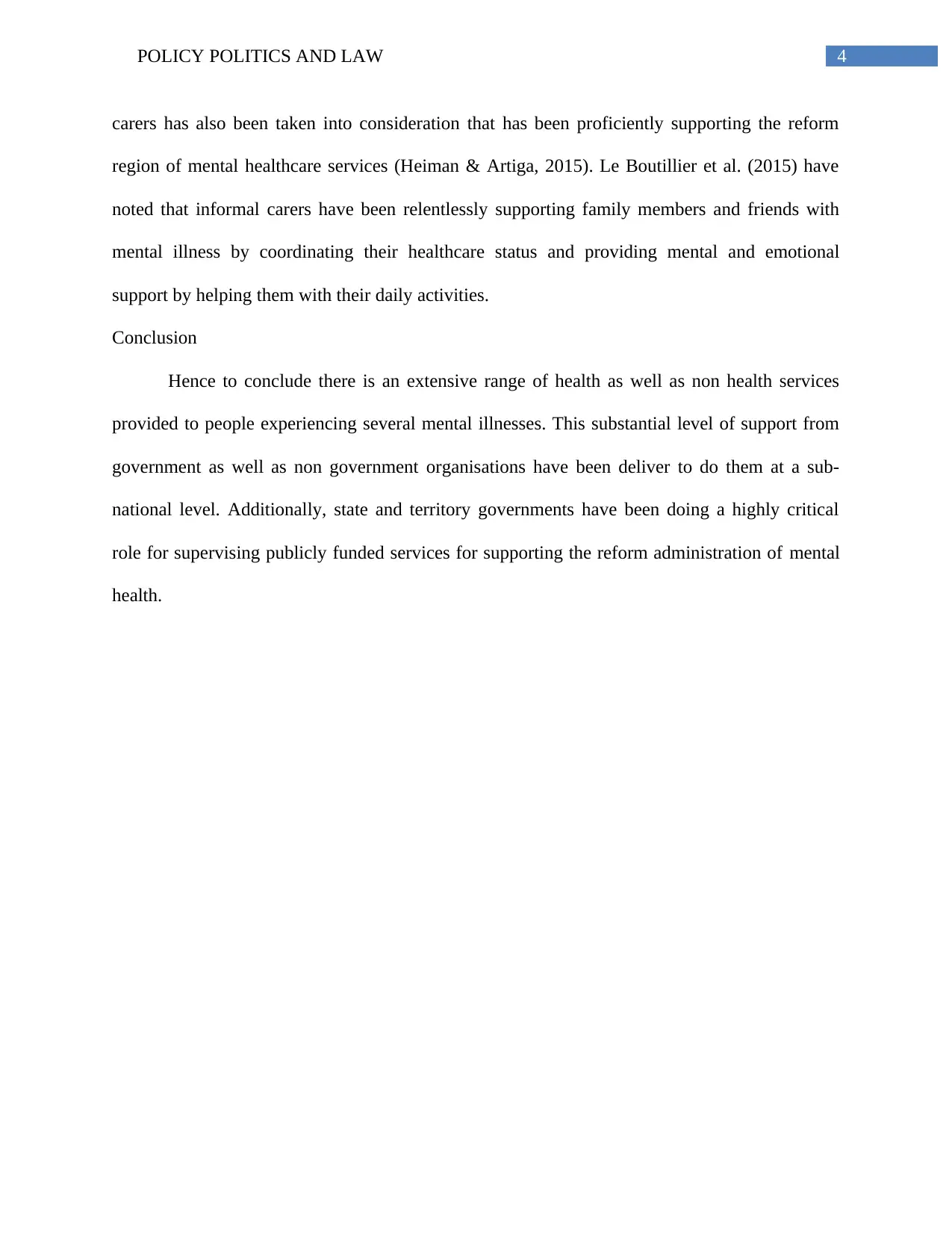
4POLICY POLITICS AND LAW
carers has also been taken into consideration that has been proficiently supporting the reform
region of mental healthcare services (Heiman & Artiga, 2015). Le Boutillier et al. (2015) have
noted that informal carers have been relentlessly supporting family members and friends with
mental illness by coordinating their healthcare status and providing mental and emotional
support by helping them with their daily activities.
Conclusion
Hence to conclude there is an extensive range of health as well as non health services
provided to people experiencing several mental illnesses. This substantial level of support from
government as well as non government organisations have been deliver to do them at a sub-
national level. Additionally, state and territory governments have been doing a highly critical
role for supervising publicly funded services for supporting the reform administration of mental
health.
carers has also been taken into consideration that has been proficiently supporting the reform
region of mental healthcare services (Heiman & Artiga, 2015). Le Boutillier et al. (2015) have
noted that informal carers have been relentlessly supporting family members and friends with
mental illness by coordinating their healthcare status and providing mental and emotional
support by helping them with their daily activities.
Conclusion
Hence to conclude there is an extensive range of health as well as non health services
provided to people experiencing several mental illnesses. This substantial level of support from
government as well as non government organisations have been deliver to do them at a sub-
national level. Additionally, state and territory governments have been doing a highly critical
role for supervising publicly funded services for supporting the reform administration of mental
health.
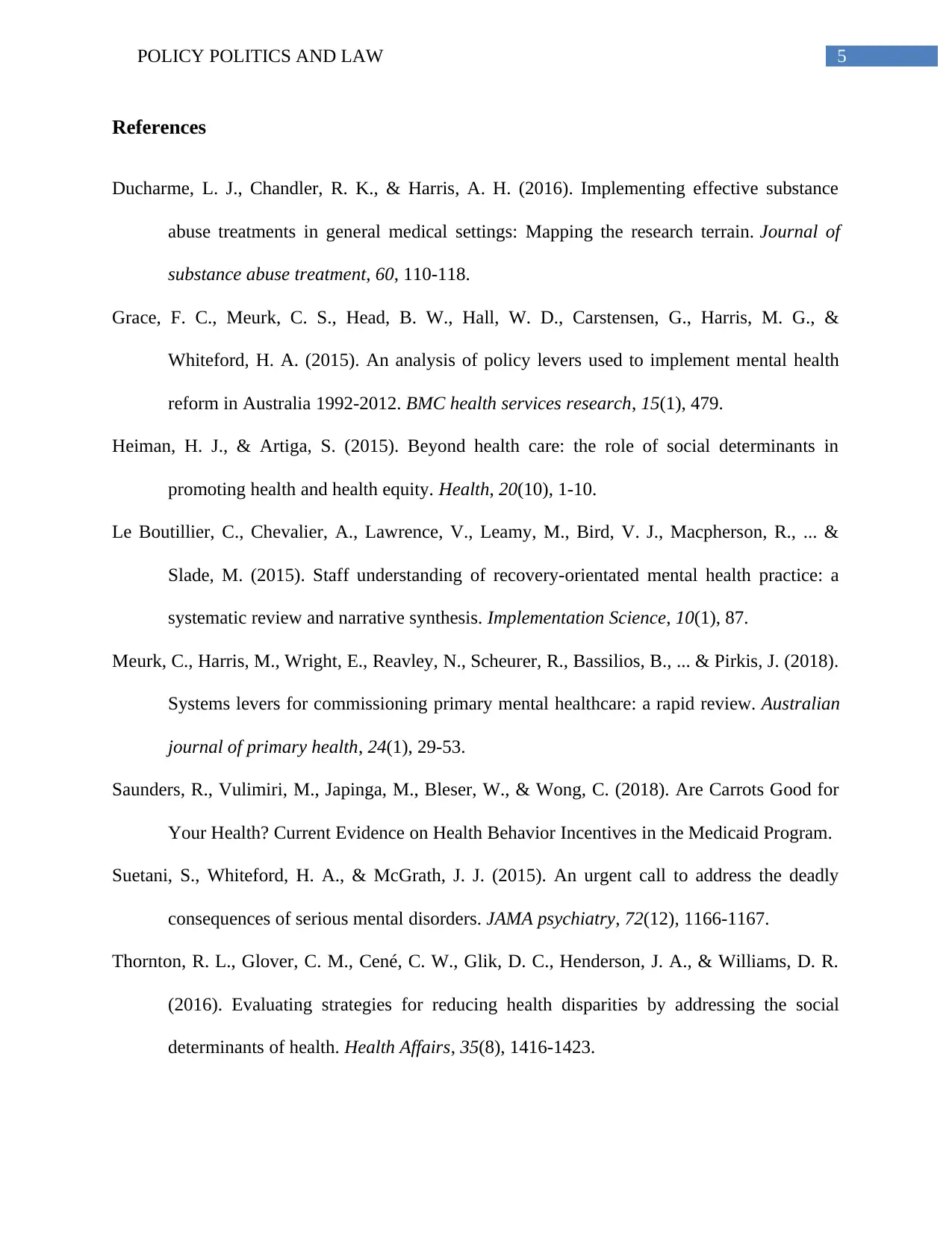
5POLICY POLITICS AND LAW
References
Ducharme, L. J., Chandler, R. K., & Harris, A. H. (2016). Implementing effective substance
abuse treatments in general medical settings: Mapping the research terrain. Journal of
substance abuse treatment, 60, 110-118.
Grace, F. C., Meurk, C. S., Head, B. W., Hall, W. D., Carstensen, G., Harris, M. G., &
Whiteford, H. A. (2015). An analysis of policy levers used to implement mental health
reform in Australia 1992-2012. BMC health services research, 15(1), 479.
Heiman, H. J., & Artiga, S. (2015). Beyond health care: the role of social determinants in
promoting health and health equity. Health, 20(10), 1-10.
Le Boutillier, C., Chevalier, A., Lawrence, V., Leamy, M., Bird, V. J., Macpherson, R., ... &
Slade, M. (2015). Staff understanding of recovery-orientated mental health practice: a
systematic review and narrative synthesis. Implementation Science, 10(1), 87.
Meurk, C., Harris, M., Wright, E., Reavley, N., Scheurer, R., Bassilios, B., ... & Pirkis, J. (2018).
Systems levers for commissioning primary mental healthcare: a rapid review. Australian
journal of primary health, 24(1), 29-53.
Saunders, R., Vulimiri, M., Japinga, M., Bleser, W., & Wong, C. (2018). Are Carrots Good for
Your Health? Current Evidence on Health Behavior Incentives in the Medicaid Program.
Suetani, S., Whiteford, H. A., & McGrath, J. J. (2015). An urgent call to address the deadly
consequences of serious mental disorders. JAMA psychiatry, 72(12), 1166-1167.
Thornton, R. L., Glover, C. M., Cené, C. W., Glik, D. C., Henderson, J. A., & Williams, D. R.
(2016). Evaluating strategies for reducing health disparities by addressing the social
determinants of health. Health Affairs, 35(8), 1416-1423.
References
Ducharme, L. J., Chandler, R. K., & Harris, A. H. (2016). Implementing effective substance
abuse treatments in general medical settings: Mapping the research terrain. Journal of
substance abuse treatment, 60, 110-118.
Grace, F. C., Meurk, C. S., Head, B. W., Hall, W. D., Carstensen, G., Harris, M. G., &
Whiteford, H. A. (2015). An analysis of policy levers used to implement mental health
reform in Australia 1992-2012. BMC health services research, 15(1), 479.
Heiman, H. J., & Artiga, S. (2015). Beyond health care: the role of social determinants in
promoting health and health equity. Health, 20(10), 1-10.
Le Boutillier, C., Chevalier, A., Lawrence, V., Leamy, M., Bird, V. J., Macpherson, R., ... &
Slade, M. (2015). Staff understanding of recovery-orientated mental health practice: a
systematic review and narrative synthesis. Implementation Science, 10(1), 87.
Meurk, C., Harris, M., Wright, E., Reavley, N., Scheurer, R., Bassilios, B., ... & Pirkis, J. (2018).
Systems levers for commissioning primary mental healthcare: a rapid review. Australian
journal of primary health, 24(1), 29-53.
Saunders, R., Vulimiri, M., Japinga, M., Bleser, W., & Wong, C. (2018). Are Carrots Good for
Your Health? Current Evidence on Health Behavior Incentives in the Medicaid Program.
Suetani, S., Whiteford, H. A., & McGrath, J. J. (2015). An urgent call to address the deadly
consequences of serious mental disorders. JAMA psychiatry, 72(12), 1166-1167.
Thornton, R. L., Glover, C. M., Cené, C. W., Glik, D. C., Henderson, J. A., & Williams, D. R.
(2016). Evaluating strategies for reducing health disparities by addressing the social
determinants of health. Health Affairs, 35(8), 1416-1423.
⊘ This is a preview!⊘
Do you want full access?
Subscribe today to unlock all pages.

Trusted by 1+ million students worldwide
1 out of 6
Related Documents
Your All-in-One AI-Powered Toolkit for Academic Success.
+13062052269
info@desklib.com
Available 24*7 on WhatsApp / Email
![[object Object]](/_next/static/media/star-bottom.7253800d.svg)
Unlock your academic potential
Copyright © 2020–2025 A2Z Services. All Rights Reserved. Developed and managed by ZUCOL.




